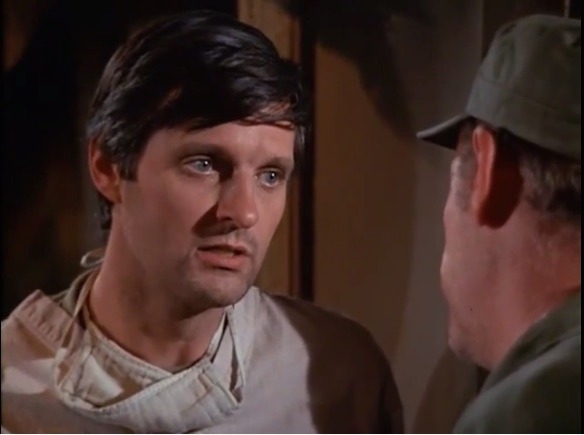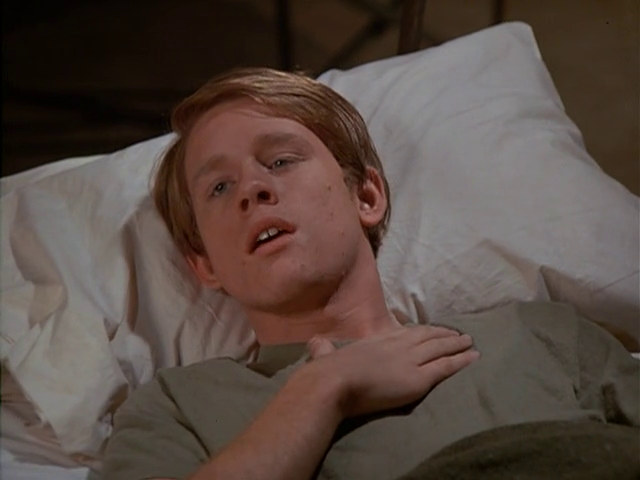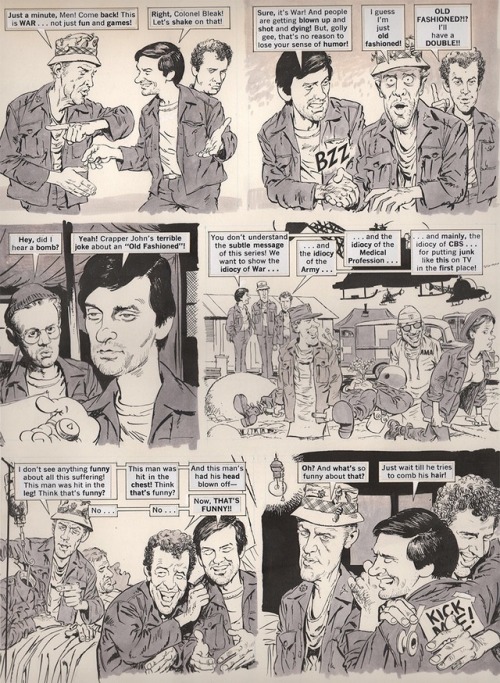#m a s h

There’s a subtle dirty joke in this one too: in his tent having martinis with Nancy, Hawkeye complains about the black market Chinese olives: “You can’t conquer the world with a shoddy olive. Hitler found that out.” That this remarkable episode, which moves so effortlessly between comedy and tragedy, found time to include a jab on Hitler’s testicle is just one more reason it’s a masterpiece.
Let’s be real here: “Bullet” is the best episode of M*A*S*H season 1; the best episode of M*A*S*H, period; and almost certainly in the top 20 TV episodes of all time, of any series. I have my own favorites, but even I must admit this. Larry Gelbart et al set out to take a compelling story about horny war doctors and give it something extra, push the existential element to a bigger, universal place. With “Bullet,” they achieved what they were going for. It’s the yardstick against which all other MASH shows can be measured, and should be.

Hawkeye’s heart breaks when he’s unable to save the life of his childhood friend Tommy Gillis. Tommy has enlisted in a regiment so he can write a book, with the working title You Never Hear the Bullet, and pops by the Swamp for a rowdy, joyful visit. He returns mortally wounded—telling Hawk, with his last breath on the operating table, that he heard the bullet after all. His death, and Hawk’s grief, give rise to Henry Blake’s famous speech of comfort, repeated by fans frequently. “Rule number one is young men die. And rule number two is, doctors can’t change rule number one.”

Subject matter with this kind of weight might seem out of place in a comedy, and it was indeed an extremely daring thing to try. MASH swung for the fences, with miraculous success. Part of why it succeeded, though, is that amid its wrenching drama the show is funny. Frank throws his back out while trying to sail into Margaret, and decides he deserves a Purple Heart for it. Incredibly, he gets one—which Hawkeye steals to give to Walter Peters, a boy who lied about his age to become a Marine (in order to impress a girl, who will flip when she sees the medal). Ron Howard is impeccable and the interplay between Peters and Hawkeye, while still serious, is lighter, providing a balance with the bleaker half of the story.
Finally, we will never forget the way Tommy planted one on Henry at their first meeting, shown again as a freeze-frame in the closing credits.

Love, without inferior olives, really does conquer all.
Page from MAD #166, published 1974. “M*A*S*H-UGA,” art by Angelo Torres. More here: bit.ly/2quoFAL
Post link

So, Houlihan and Burns (but Houlihan especially) are extremely upset that Radar seems to be getting romantic with an officer, Louise Anderson. Even though they only saw them talking together at lunch? With Hawk and Trapper also present? It strains credibility a bit. If pressed, I’d say that what this show is missing is any real heat between Radar and Lt. Anderson, beyond his smitten first encounter with her when he carries her bag. By now (14 episodes into season 1) the show’s creators should know that we’re in this mainly for the sex. Louise has a flirty moment with Hawkeye in her tent which surpasses anything that ever goes on between her and Corporal O’Reilly—this is just unfair.
That said, Kelly Jean Peters is great as the intellectual object of Radar’s affection. She looks like someone from now, maybe an adjunct professor at a Midwestern grad school, as much as like a 1950s military nurse. (She doesn’t look like a ‘70s lady at all, strangely enough.) Though her tastes in music and literature force Radar to jump through cognitive hoops and ultimately bore him to sleep, she succeeds in taking his mind off his broken engagement. Pity she didn’t come back a few years later to give Winchester a try.

My favorite parts of the episode are at the front end, however, before Anderson has even appeared. We see what made Gary Burghoff such a sublime Charlie Brown, as he sulks in the mess hall and lies in fetal position listening to his sweetheart’s “Dear John” record. (I wish I knew who did the voice of Linda Sue.) The doctors put him through a battery of tests to find the cause of his sadness, and he’s funny throughout, sweetly patient with a subtle air of irritation.

The episode title is a reference to the film of the same name, which was huge at that moment and a hundred times sappier than MASH. We’ll take Radar’s love life over Ryan O’Neal’s. We’ll also take Hawk and Trapper having “pillow talk” in Margaret’s bed.

Studios are Painless

MASH famously had two shooting locations: a soundstage in Hollywood, and an outdoor location called “the camp” in Malibu, that cast and crew traveled to from the city. It’s usually easy to see whether scenes have been shot inside—the lighting gives it away, as does the occasional fake look of sky and plants. (I think my cinematographer dad will be proud that I can recognize this, but really, most people can.) The outdoor scenes, by contrast, are gorgeously lit and have an airy, free appearance that really enhances everything. It’s that California sunshine.

The reason for this was practical. They couldn’t do everything outside because the light was only good for a certain amount of time, so they did what they could at the beautiful site, then took care of the rest in a more functional, traditional place. Unintentional though this is, I think the duality of MASH is neatly encapsulated in these two studios. The soundstage was what the show was, or, if you will, what the very convention of television was; the camp was what it was becoming. It makes sense that the entire opening credits sequence is outdoors. In season 2, “The Sniper” would use the outdoor location to full effect, as various people at different places in the MASH dodged a gunman’s fire. Soon, ambitious shots using the camp would become commonplace, as when Col. Potter rides his horse up to meet the choppers in season 4.

The inside scenes were necessary, though, and MASH wouldn’t be MASH without them. Especially at first, the audience was on board for the world of the laugh track, the funny music cue, and the reaction shot. Even as the series grew in sophistication these stayed on, to varying degrees, until the end.




